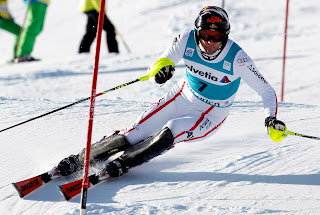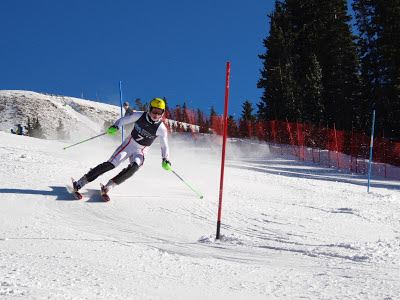Read this to get a good start
This is a good start, I wrote this a few years ago and there are a few observations and insights that can be added. I don't think it needs amending, as I just read it critically and it still stands up. However, I have added in a few critical sections, a few sentences or paragraphs to enhance the understanding of carving on ice.
Carving on hard snow or encountering a patch of slick stuff, can be challenging even for the best skiers. Everything has to be perfect and you can't over react or panic.
Carving on ice is a process of setting up the new arc, by starting with the correct releasing actions from the previous arc. The releasing movements are all lateral movements of the lower body and they get the skis off their edges, through flat, to their new edges.
How to move the boots and skis to angles.
To get the boots and skis engaged, you have to have lateral pressure with the ankle against the medial/inside, and lateral/outside, sidewalls of the boots. The beginning edge angles which are small, require lateral side pressure on the releasing boot and medial pressure on the outside boot. This is the real essence of the edge hold on really slick polished snow. The foot and ankle pressure exerted toward the sides of the boots create tipping movements and ski angles. So awareness, sensitivity and movement capability inside the boot to the side of the boot wall are Essential. Not every skier has developed these patterns, so there is a training and learning phase involved before you can carve on slick ice.
This is the tentative or uncertainty phase at the very early part of the arc, called the “High C”. You have not yet started gipping/holding, but you are not skidding. In transition, you have to keep your hips centered laterally, moving only the skis, boots and legs, not the hips, and do so without pushing, extending or creating pressure. The legs have to be flexed and
bending from the release of last arc, into the top of the new arc.
Here Julien Lizeroux, French world cup skier, in transition, shows tipping, lower body movements, just before engaging.

Once you have increased the ski angles and lower body tipping, and established balance, you can come inside the arc with the hips (below photo). The upper body remains tilted toward the outside ski (vertical zipper on the jacket/ counter balanced) and this must be established early during the edge change, this move is called counter balancing. If you can use your ankles and feet (proper footbed with right amount of flexibility for foot eversion is critical) do not try to grip in the upper third of the turn. This is a very delicate point. Ride on the skis edges and increase the edge angles delicately and progressively until the falline. If you move too quickly or use even a slight twist or steering action, you are lost. Friction or grip is hard to come by during this phase of the turn, so skiers have a tendency to want to over grip. Over gripping comes out in many ways, knee drive, leg extension, steering, none of these methods will result in a carved turn. Once you are at the falline allow the outside leg to lengthen, or extend, by tipping and flexing the inside leg, and let the inside hip drop by relaxing, to the inside of the arc. The inside ski must be tipping aggressively through the whole turn, but should be lightly weighted or pressured.
Marcel Hirscher moves inside the arc, feet pulled back and counter balanced.
Role of Fore/aft balance.
Keeping the hips up over the boot (fore/aft) is an often forgotten golden rule of ice carving. Once you establish the ankle and hip angles to the inside of the arc, the leg (shin) can lever, rather aggressively toward the inside and front corner of the cuff. If you want to shorten the arc or keep a carve on steep ice keeping the hips forward and the feet and boots pulled back under your hips, is mandatory. Reminder, ankle and foot side pressure on the boot and hip angle have to be in place before you use the shin to pressure the boot. If you use the shin first, you will definitely lose the tail and possibly the whole ski. Hip countering movements occur after the skis are tipped and engaged enough so they can no longer pivot. This requires a high level of edge sensitivity. Counter acting movements are an important component of this successful approach to skiing slick, steep ice. However they have to be initiated with a certain finesse, or they will disrupt the tenuous edge hold.

Deville, Once you are at the falline allow the outside leg to lengthen, or extend, by tipping and flexing the inside leg, and let the inside hip drop by relaxing, to the inside of the arc.
Obviously any upper body rotation, or dropping of the inside hand during this turn phase is a sure way to lose the ski. Many skiers can hold and carve on good snow with some rotation of the upper body and leaning, but as soon as the snow gets really slick they are lost.
Transition:
The other important part of ice skiing is using the proper transition movements. If you are using an up or vertical push from the ski edge, you will never carve on ice. You might bite at the end of the turn, but carving will be lost. You can learn to make turns like this with a solid program of balancing and ski use exercises. What we could add here is that in the High C part of the arc, where you are in a flexed/bend knee relationship and coming out of transition, both knees should have the same amount of bend for a moment. Tipping the previous stance ski onto the little toe edge is the key, it has to be done gingerly without a big body parts moving, like hips or torso. This is the tenuous or uncertainty phase of the arc. This is why we advocate holding the previous counter through transition. If you make a movement toward the new arc with either extension or hip reversing, you will skid the tails. First you have to be able to get firm enough engagement of the ski and boot angle to the snow.
The transition is also described as the skis coming from a highly tipped angle, in the previous arc, to the next arc, highly tipping and engaged. This has to be a continuous movement, once releasing begins, from one side to the other. The non interrupted, continuous lateral movements of the skis, boots and legs following the skis, is the key to a progressive engagement of the new arc.
What can go wrong?
The goal of craving on ice is attainable. The goal of speed control in carved arcs is also attainable on moderate terrain. The goal of speed control and carving on steep ice is still a major milestone, and very difficult.








































